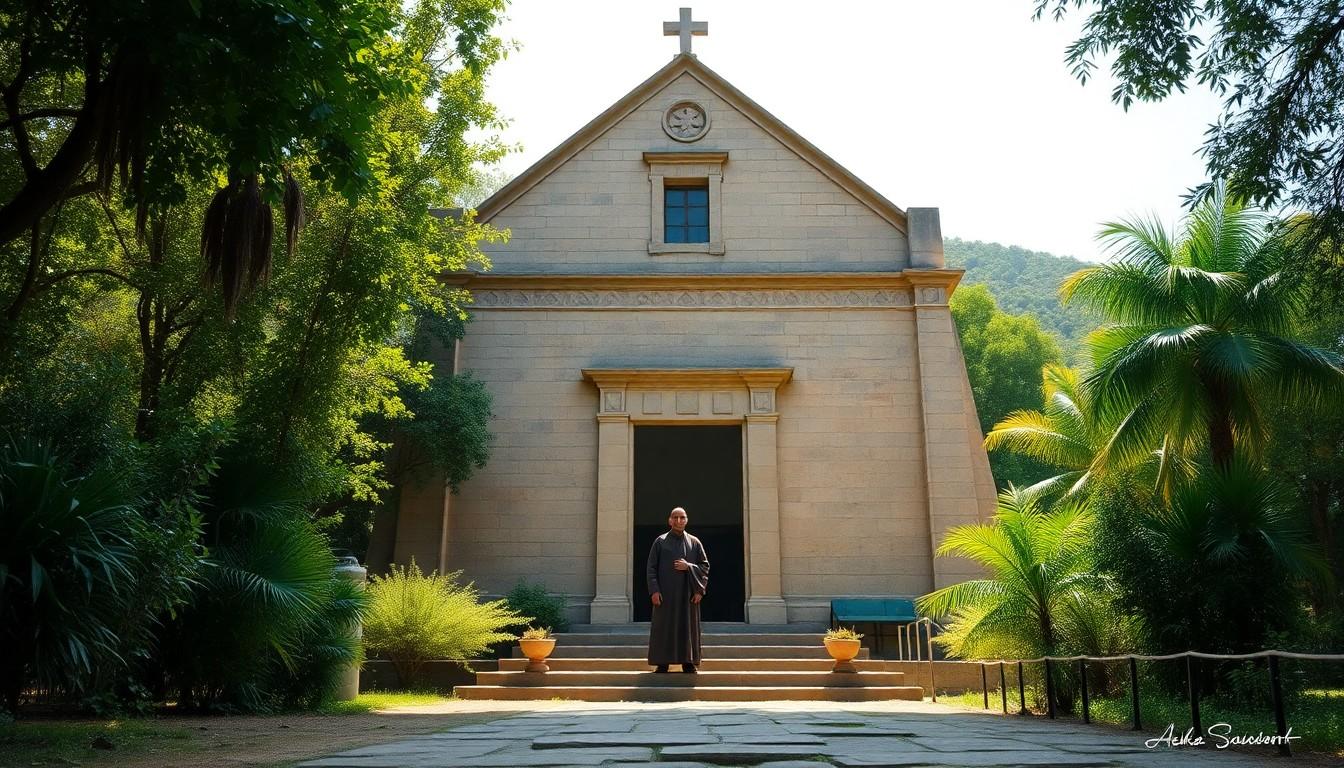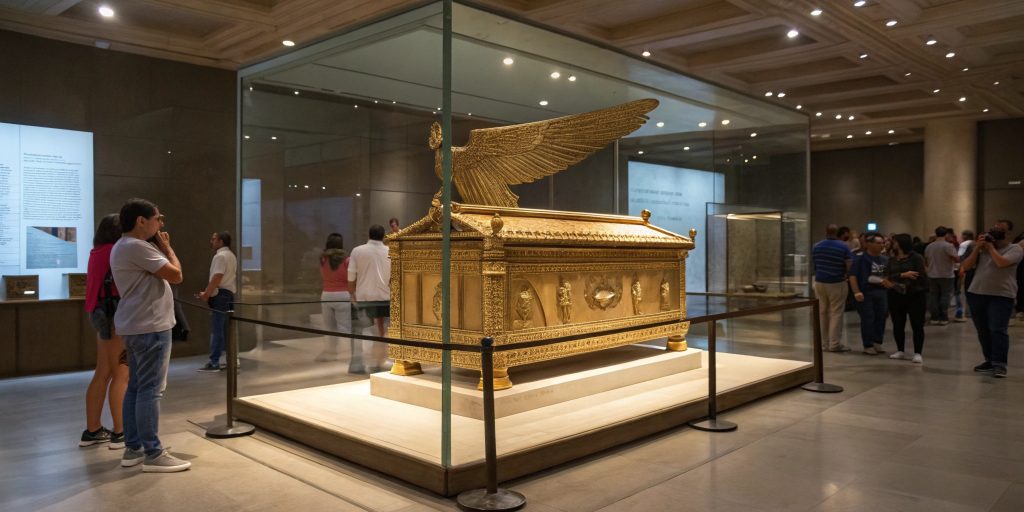The Ark of the Covenant remains one of history’s most intriguing religious artifacts, captivating scholars, archaeologists, and believers for centuries. This sacred chest, described in the Bible as housing the Ten Commandments, has sparked countless expeditions and theories about its whereabouts since its mysterious disappearance around 587 BCE.
Despite numerous discovery claims, the Ark’s location continues to elude researchers. From the depths of Ethiopia’s churches to Jerusalem’s hidden chambers, various locations have been proposed as the final resting place of this powerful biblical relic. While some researchers believe they’re close to finding it, others question whether it still exists.
The Biblical Significance of the Ark of the Covenant
The Ark of the Covenant represents a sacred artifact of unparalleled importance in biblical history. According to biblical texts, God commanded Moses to construct this holy chest during the Israelites’ journey through the wilderness.
The physical specifications of the Ark demonstrate its precise craftsmanship:
| Dimension | Measurement |
|---|---|
| Length | 45 inches |
| Width | 27 inches |
| Height | 27 inches |
The Ark’s construction featured specific materials and elements:
- Acacia wood core structure
- Pure gold overlay inside and out
- Golden crown molding around the top
- Four gold rings for carrying poles
- Two golden cherubim on the lid
Sacred contents housed within the Ark included:
- Stone tablets containing the Ten Commandments
- Golden pot of manna
- Aaron’s rod that budded
- Original scrolls of the covenant
The Ark served multiple divine purposes:
- Housed sacred objects of the Israelite faith
- Represented God’s throne on Earth
- Manifested divine presence among the people
- Served as the center of worship and religious ceremonies
- Led the Israelites in their wilderness journey
Throughout biblical accounts, the Ark demonstrated supernatural properties:
- Parted the Jordan River
- Brought victory in battles
- Caused plagues upon enemies
- Protected its bearers when adequately handled
- Struck down those who touched it inappropriately
The Ark’s presence in biblical narratives spans from its construction at Mount Sinai to its placement in Solomon’s Temple, which remained until the Babylonian invasion of Jerusalem. Its significance extends beyond its physical attributes, representing the tangible symbol of God’s covenant with the Israelites and marking the intersection of divine and human realms in biblical history.
Historical Accounts of the Ark’s Disappearance

The Ark of the Covenant’s disappearance remains one of history’s most intriguing mysteries. Historical records track its presence until 586 BCE, after which the sacred artifact vanishes from documented history.
The Temple of Solomon
The Temple of Solomon housed the Ark of the Covenant in a specially designated chamber called the Holy of Holies. King Solomon placed the Ark in this innermost sanctuary during the temple’s dedication ceremony in 957 BCE, where it remained under the protection of temple priests for approximately 370 years. Ancient Jewish texts describe the Holy of Holies as a perfect cube measuring 20 cubits in each direction, with the Ark positioned on a foundation stone known as the Even ha-Shetiyah.
Babylonian Conquest Theory
The Babylonian invasion of Jerusalem in 586 BCE marks the last verified historical reference to the Ark’s location. The absence of the Ark in the detailed lists of treasures captured by the Babylonian forces raises questions about its fate during this period. While Babylonian records meticulously document other temple artifacts seized during the conquest, they contain no mention of the Ark. Historical accounts from this period offer three possibilities:
- Destruction during the temple siege
- Capture by Babylonian forces
- Removal by temple priests before the invasion
Multiple archaeological excavations in Babylon’s ancient ruins have uncovered various temple artifacts but revealed no evidence of the Ark. This absence of physical evidence continues to fuel scholarly debate about the artifact’s ultimate fate during this pivotal historical event.
Modern Claims and Archaeological Expeditions

Multiple expeditions have attempted to locate the Ark of the Covenant through archaeological excavations. These efforts have produced various claims about the Ark’s location, though none have provided conclusive evidence.
Ethiopian Orthodox Church Claims
The Ethiopian Orthodox Church maintains possession of the Ark in a chapel called the Church of Our Lady Mary of Zion in Axum, Ethiopia. A single guardian monk, appointed for life, protects the chapel and the alleged Ark. The church prohibits anyone else from viewing the artifact, making independent verification impossible. Ethiopian Christians trace this claim through a lineage connecting their royal dynasty to King Solomon through the Queen of Sheba.
- Lack of photographic evidence
- Absence of independent verification
- Non-compliance with standard archaeological protocols
- Missing documentation of excavation procedures
- No physical artifacts to support the discovery
Scientific Analysis of Potential Ark Locations

Archaeological investigations employ advanced technologies like ground-penetrating radar (GPR) thermal imaging to explore potential Ark locations. Scientific studies focus on two primary areas: historical records and biblical references.
Mount Nebo Research
Archaeological surveys at Mount Nebo utilize digital mapping high-resolution scanning to analyze underground chambers and caves. Researchers examine ancient materials’ geological formations and chemical compositions to identify potential storage locations matching biblical descriptions. Remote sensing technologies detect anomalies beneath the surface, revealing structural patterns consistent with ancient storage practices.
Jerusalem Temple Mount Studies
Scientific investigations beneath the Temple Mount employ:
- Ground-penetrating radar scanning beneath the Foundation Stone
- Chemical analysis of rock formations in underground tunnels
- Infrared imaging of sealed chambers in ancient passages
- Seismic surveys to map underground structures
- Microscopic analysis of collected soil samples
Current research focuses on Ron Wyatt’s claimed discovery site in a cave outside Jerusalem’s old walls. The chamber he described contained:
| Feature | Description |
|---|---|
| Location | Beneath crucifixion site |
| Chamber contents | Rocks treasures |
| Key evidence | Black substance on the mercy seat |
| Dating analysis | Inconclusive results |
| Archaeological documentation | No verified artifacts |
Scientific protocols require independent verification documentation of findings, which remains absent from the claimed discoveries. Analysis continues at multiple sites using modern archaeological methods and technological tools to examine potential locations supported by historical textual evidence.
Challenges in Authenticating Ark-Related Discoveries
Archaeological authentication of claimed Ark discoveries faces significant obstacles due to multiple verification barriers. Ron Wyatt’s 1982 discovery claim in Jerusalem’s Garden Tomb exemplifies these challenges through three key authentication issues:
- Documentation Problems
- Absence of clear photographic evidence
- Reportedly corrupted or blurry video footage
- Missing detailed excavation records
- Lack of proper archaeological documentation
- Access Restrictions
- Limited access to claimed discovery sites
- Religious restrictions on artifact examination
- Protected sacred spaces preventing investigation
- Restricted entry to underground chambers
- Physical Evidence Gaps
- No verifiable artifacts from discovery sites
- Missing archaeological context documentation
- Absence of independent scientific analysis
- Lack of preserved material evidence
Modern authentication protocols demand specific evidence types to verify archaeological discoveries:
- High-resolution photographs
- Detailed excavation records
- Independent expert verification
- Scientific dating analysis
- Documented chain of custody
- Archaeological context documentation
- Material composition analysis
- Artifact preservation evidence
The absence of these authentication elements in Ark-related claims creates significant credibility gaps. Archaeological institutions require comprehensive documentation packages, including site surveys, stratigraphic analysis, artifact catalogs, and conservation reports. Without meeting these established scientific standards, claimed discoveries remain unverified speculation rather than confirmed historical finds.
| Authentication Requirement | Current Status |
|---|---|
| Clear photographs | Not available |
| Video documentation | Corrupted/Blurry |
| Expert verification | None completed |
| Scientific analysis | Not performed |
| Excavation records | Incomplete |
The Ongoing Global Search Efforts
Current archaeological expeditions persist in multiple locations across the Middle East, searching for the Ark of the Covenant. To explore potential sites, professional teams employ advanced technological tools, including ground-penetrating radar, thermal imaging cameras, and 3D mapping systems.
Key ongoing search locations include:
- Temple Mount Complex: Archaeological teams conduct systematic surveys beneath Jerusalem’s Temple Mount using non-invasive scanning equipment
- Qumran Caves: Researchers examine newly discovered cave systems near the Dead Sea where ancient religious artifacts were previously found
- Ethiopian Highlands: Scientific expeditions investigate claims around the Church of Our Lady Mary of Zion in Axum
- Mount Nebo Region: Professional archaeologists utilize digital mapping technology to analyze underground chambers
Notable recent investigation methods include:
- Remote sensing technology for subsurface imaging
- Chemical analysis of soil samples from probable locations
- Digital reconstruction of historic structures
- Geological surveys of cave systems
- Documentation of oral traditions related to the Ark
One significant claimed discovery came from Ron Wyatt in 1982, who reported finding the Ark in a cave beneath Jerusalem’s crucifixion site. His account includes:
| Discovery Details | Claimed Evidence |
|---|---|
| Location | The cave system under Jerusalem |
| Date | January 6, 1982 |
| Associated Items | Golden censer, Roman sword, ephod |
| Documentation | Limited photographs, no verified artifacts |
Modern archaeological standards require substantial evidence to verify such claims. Current search efforts focus on gathering measurable data through scientific methods rather than relying on unsubstantiated reports.
Conclusion
The search for the Ark of the Covenant continues to captivate researchers, archaeologists, and religious scholars worldwide. While numerous discovery claims have emerged throughout history, no conclusive evidence has been provided that meets modern scientific standards.
The combination of advanced technology, historical research, and dedicated exploration keeps hope alive for finding this sacred artifact. However, the lack of verifiable evidence, photographic documentation, and independent verification of claimed discoveries leaves the Ark’s location a mystery.
Whether the Ark still exists remains uncertain, but its historical and religious significance ensures that the quest for its discovery will persist. Until concrete proof emerges, the Ark’s whereabouts will remain one of history’s most intriguing mysteries.

